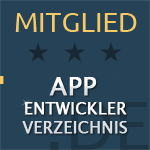
Insight

Insight

Insight
From Code to Success: Flutter Optimizes the Development Process


Julian Giesen
·
·
Monday, October 21, 2024


Julian Giesen
Customers expect user-friendly, powerful, and well-designed apps that work seamlessly across various platforms like iOS and Android. However, this is where the challenge begins: Developing native apps for both platforms often entails high efforts. Developers must maintain separate codebases, which is not only time-consuming but also drives up costs.
Furthermore, there is often the problem of fragmentation: New versions of operating systems or different device requirements require continuous updates and adjustments. This means developers must spend considerable time maintaining and updating apps to ensure they run smoothly on all devices.
This is where Flutter comes into play. Flutter, the framework developed by Google, promises a solution to these issues by significantly simplifying the development and maintenance of apps for multiple platforms. Flutter allows the creation of apps with a single codebase that work exceptionally well on both iOS and Android. Companies benefit from faster development, lower costs, and greater flexibility in launching their products.
By eliminating traditional barriers to app development, Flutter offers an innovative way to create modern mobile apps more efficiently – and without compromising on quality.
Why Flutter Accelerates the Development Process
One of the main reasons why Flutter makes the development process so efficient is its ability to work with a single codebase for multiple platforms. This means you no longer need two separate teams for iOS and Android development, saving both time and resources. This “write once, run anywhere” approach allows developers to write an application that runs almost identically on both platforms. This not only leads to shorter development times but also simplifies maintenance and results in lower long-term costs.
Another key feature of Flutter is the so-called “Hot Reload.” This term describes a feature that allows developers to see code changes in real-time without having to restart the application. This significantly speeds up development cycles, as bugs or improvements are instantly visible and can be tested immediately. Developers can thus implement their ideas faster and fix problems more quickly. The entire development process becomes more dynamic and iterative, leading to a substantial reduction in time-to-market.
But Flutter not only saves time in development but also in performance. Since Flutter uses the Dart programming language and works directly with the Flutter engine, the code is compiled directly into native machine code. This results in impressive performance that can compete with native apps. Unlike other cross-platform solutions that often rely on bridges between platforms to execute the code, Flutter provides a smooth and fast experience – for both developers and users.
For companies, this means they can respond more quickly to market demands. The ability to develop, test, and release faster gives them a clear competitive advantage. Changes or new features can be integrated easily without the need to restart the entire development process from scratch. This not only saves development time but also costs associated with long feedback loops in traditional approaches.
Speed and Quality: Flutter Compared to Native Development Approaches
A widespread misconception in app development is that cross-platform frameworks like Flutter compromise performance and quality compared to native development approaches. However, Flutter turns this assumption on its head by offering nearly native performance while reaping the benefits of a single codebase for multiple platforms. Let’s take a closer look at how Flutter combines speed and quality while surpassing traditional development approaches.
Performance Advantages Through Dart and the Flutter Engine
A crucial factor for Flutter’s performance is the use of the Dart programming language. Dart compiles the code directly into native machine code, which means no additional bridges or interpreters are needed to run the app. This makes a significant difference compared to other cross-platform solutions like React Native, which often use JavaScript bridge technologies, potentially leading to noticeable delays in execution. Flutter, on the other hand, runs directly on the hardware. This results in a fast and responsive user interface.
Additionally, Flutter uses its own rendering engine, which works independently of native UI components from Android and iOS. This means developers have full control over design and animations without encountering platform-specific limitations. Complex animations and smooth transitions are possible with Flutter just as they are with native frameworks, often even faster because the overhead is minimized.
No Compromises in User Experience
The concern that cross-platform solutions generally do not provide optimal user experiences is unfounded with Flutter. The widgets in Flutter are designed to adapt seamlessly to their respective platforms. When an app runs on iOS, it feels to the user like a native iOS app, and the same applies to Android. Flutter also allows the use of specific UI elements for each platform without having to completely separate the codebase. This ensures that the user experience remains excellent on both platforms.
Moreover, the loading times of Flutter apps are impressive. Since Flutter apps are pre-compiled, there are no delays during startup or rendering of UI elements. The fluid operation typical of native apps is thus preserved even in Flutter apps.
Fast Time to Market and Operational Efficiency
One of the biggest advantages Flutter offers over native development approaches is the time savings in getting to market. Companies can respond much more quickly when it comes to releasing new features or updates. This is because the development process is simplified by the shared codebase. A new feature only needs to be developed once and can then be rolled out for both platforms. This reduces not only the development time but also the QA phase, as it requires fewer platform-specific tests.
The accelerated time to market provides companies with a significant competitive advantage. They can bring new features or improvements to market faster than the competition while simultaneously saving resources that would otherwise be spent on duplicate development and testing processes in native development approaches.
Benefits for Companies: More Efficiency, Fewer Resources
For companies involved in app development, efficiency plays a central role. Time, budget, and resources are often limited, and any delay or additional development step can incur substantial costs. Flutter provides an ideal solution to face these challenges. Due to its technical features and cross-platform capabilities, Flutter offers a range of advantages that not only accelerate the development process but also reduce operating costs in the long term.
Reduction of Development Resources and Costs
One of Flutter's biggest advantages is the ability to use a single codebase for multiple platforms. This eliminates the need for separate developer teams for iOS and Android. Companies can use their resources more efficiently, as only one team is needed to maintain and develop the app. This not only saves on personnel costs but also reduces project management and quality assurance costs since fewer interfaces and coordination efforts are necessary.
Furthermore, Flutter significantly shortens development time. With the “Hot Reload” feature, developers can see changes to the code immediately and test them in real-time, which accelerates the debugging process and shortens feedback cycles. This leads to faster app deployment, which is especially invaluable for startups or companies with strict deadlines.
Flexible Scaling and Rapid Iterations
Flutter provides companies with incredible flexibility when it comes to scaling and further developing their apps. Since Flutter offers a stable and powerful foundation, new features and extensions can be added with minimal effort. The unified codebase allows for changes to be made simultaneously for iOS and Android without requiring double the development effort.
This flexibility becomes particularly important when companies need to respond quickly to market changes or customer feedback. With Flutter, they can iterate faster and continuously improve their apps without getting stuck in long development cycles. The accelerated iteration also means that companies can maintain their competitive edge by implementing innovations faster and bringing new features to market faster than the competition.
Flutter as a Long-Term Solution for App Maintenance
Maintaining an app can often be just as resource-intensive as the initial development. Regular updates for new operating system versions, bug fixes, and the implementation of new features typically require a lot of time and effort. With Flutter, this process is significantly simplified. As a cross-platform solution, maintenance work only needs to be done once and can then be rolled out across all platforms.
Moreover, Flutter offers high stability and future-proofing as it is developed and actively maintained by Google. Companies can rely on Flutter being supported in the future and being compatible with the latest technologies and operating systems. This reduces long-term maintenance costs and ensures that companies can keep their apps up to date with less effort.
Conclusion: How Flutter Helps Companies Succeed
Flutter has established itself as a powerful solution for companies seeking efficiency, quality, and cost savings in app development. By enabling the development of cross-platform apps with a single codebase, Flutter offers an impressive combination of speed and flexibility without compromising on performance or user experience.
For companies, this primarily means one thing: They can achieve more with fewer resources. The reduction in development time, the simplification of maintenance, and the ability to respond more quickly to market demands give companies a clear competitive advantage. Especially startups and companies that are rapidly growing or operating in a highly competitive market benefit from the short time-to-market that Flutter enables.
Additionally, Flutter creates a native user experience through its powerful engine and the use of the Dart programming language, which can compete with traditional, platform-specific development approaches. The stable, responsive apps provide users with the quality they expect from modern mobile applications, while companies retain the flexibility to adjust and scale their projects as needed.
In summary, Flutter provides a technological foundation that not only allows companies to benefit from a faster development process in the short term but also reduces operating costs and maintenance efforts in the long term. This makes Flutter a future-proof choice for companies looking to make app development more efficient while building their success strategy on a stable and flexible foundation.
All insights
All insights
“Flutter and the related logo are trademarks of Google LLC. We are not endorsed by or affiliated with Google LLC.”
“Flutter and the related logo are trademarks of Google LLC. We are not endorsed by or affiliated with Google LLC.”
Copyright ©2025. Julian Giesen. All rights reserved.
“Flutter and the related logo are trademarks of Google LLC. We are not endorsed by or affiliated with Google LLC.”






